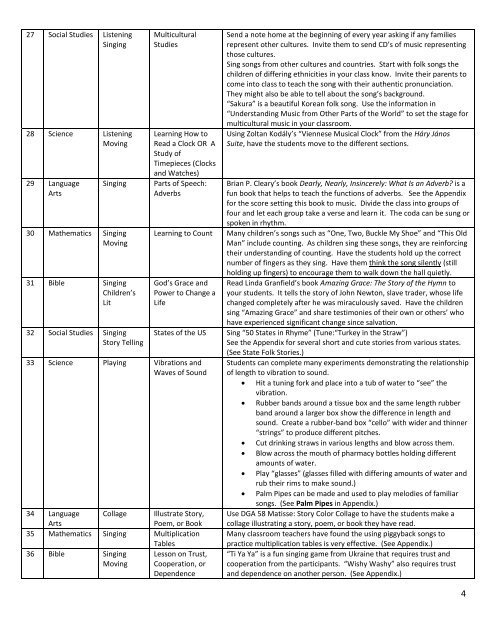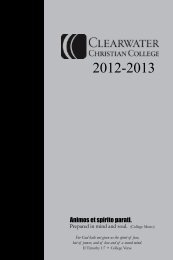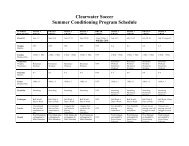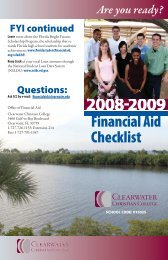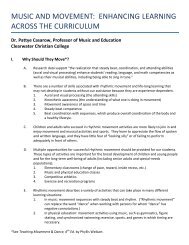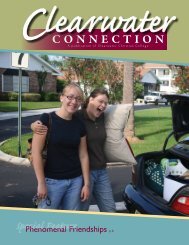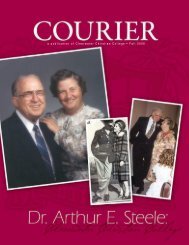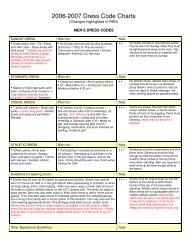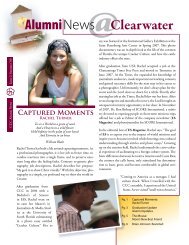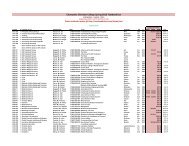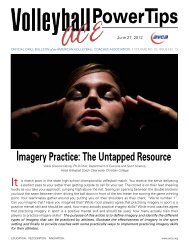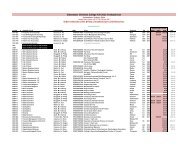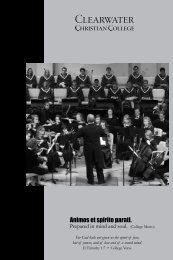101 Ways to Enrich Your Teaching with the Arts - Clearwater ...
101 Ways to Enrich Your Teaching with the Arts - Clearwater ...
101 Ways to Enrich Your Teaching with the Arts - Clearwater ...
- No tags were found...
You also want an ePaper? Increase the reach of your titles
YUMPU automatically turns print PDFs into web optimized ePapers that Google loves.
27 Social Studies Listening<br />
Singing<br />
28 Science Listening<br />
Moving<br />
29 Language<br />
<strong>Arts</strong><br />
Singing<br />
30 Ma<strong>the</strong>matics Singing<br />
Moving<br />
31 Bible Singing<br />
Children’s<br />
Lit<br />
32 Social Studies Singing<br />
S<strong>to</strong>ry Telling<br />
Multicultural<br />
Studies<br />
Learning How <strong>to</strong><br />
Read a Clock OR A<br />
Study of<br />
Timepieces (Clocks<br />
and Watches)<br />
Parts of Speech:<br />
Adverbs<br />
Learning <strong>to</strong> Count<br />
God’s Grace and<br />
Power <strong>to</strong> Change a<br />
Life<br />
States of <strong>the</strong> US<br />
33 Science Playing Vibrations and<br />
Waves of Sound<br />
34 Language<br />
<strong>Arts</strong><br />
Collage Illustrate S<strong>to</strong>ry,<br />
Poem, or Book<br />
35 Ma<strong>the</strong>matics Singing Multiplication<br />
Tables<br />
36 Bible Singing Lesson on Trust,<br />
Moving Cooperation, or<br />
Dependence<br />
Send a note home at <strong>the</strong> beginning of every year asking if any families<br />
represent o<strong>the</strong>r cultures. Invite <strong>the</strong>m <strong>to</strong> send CD’s of music representing<br />
those cultures.<br />
Sing songs from o<strong>the</strong>r cultures and countries. Start <strong>with</strong> folk songs <strong>the</strong><br />
children of differing ethnicities in your class know. Invite <strong>the</strong>ir parents <strong>to</strong><br />
come in<strong>to</strong> class <strong>to</strong> teach <strong>the</strong> song <strong>with</strong> <strong>the</strong>ir au<strong>the</strong>ntic pronunciation.<br />
They might also be able <strong>to</strong> tell about <strong>the</strong> song’s background.<br />
“Sakura” is a beautiful Korean folk song. Use <strong>the</strong> information in<br />
“Understanding Music from O<strong>the</strong>r Parts of <strong>the</strong> World” <strong>to</strong> set <strong>the</strong> stage for<br />
multicultural music in your classroom.<br />
Using Zoltan Kodály’s “Viennese Musical Clock” from <strong>the</strong> Háry János<br />
Suite, have <strong>the</strong> students move <strong>to</strong> <strong>the</strong> different sections.<br />
Brian P. Cleary’s book Dearly, Nearly, Insincerely: What Is an Adverb is a<br />
fun book that helps <strong>to</strong> teach <strong>the</strong> functions of adverbs. See <strong>the</strong> Appendix<br />
for <strong>the</strong> score setting this book <strong>to</strong> music. Divide <strong>the</strong> class in<strong>to</strong> groups of<br />
four and let each group take a verse and learn it. The coda can be sung or<br />
spoken in rhythm.<br />
Many children’s songs such as “One, Two, Buckle My Shoe” and “This Old<br />
Man” include counting. As children sing <strong>the</strong>se songs, <strong>the</strong>y are reinforcing<br />
<strong>the</strong>ir understanding of counting. Have <strong>the</strong> students hold up <strong>the</strong> correct<br />
number of fingers as <strong>the</strong>y sing. Have <strong>the</strong>m think <strong>the</strong> song silently (still<br />
holding up fingers) <strong>to</strong> encourage <strong>the</strong>m <strong>to</strong> walk down <strong>the</strong> hall quietly.<br />
Read Linda Granfield’s book Amazing Grace: The S<strong>to</strong>ry of <strong>the</strong> Hymn <strong>to</strong><br />
your students. It tells <strong>the</strong> s<strong>to</strong>ry of John New<strong>to</strong>n, slave trader, whose life<br />
changed completely after he was miraculously saved. Have <strong>the</strong> children<br />
sing “Amazing Grace” and share testimonies of <strong>the</strong>ir own or o<strong>the</strong>rs’ who<br />
have experienced significant change since salvation.<br />
Sing “50 States in Rhyme” (Tune:“Turkey in <strong>the</strong> Straw”)<br />
See <strong>the</strong> Appendix for several short and cute s<strong>to</strong>ries from various states.<br />
(See State Folk S<strong>to</strong>ries.)<br />
Students can complete many experiments demonstrating <strong>the</strong> relationship<br />
of length <strong>to</strong> vibration <strong>to</strong> sound.<br />
Hit a tuning fork and place in<strong>to</strong> a tub of water <strong>to</strong> “see” <strong>the</strong><br />
vibration.<br />
Rubber bands around a tissue box and <strong>the</strong> same length rubber<br />
band around a larger box show <strong>the</strong> difference in length and<br />
sound. Create a rubber-band box “cello” <strong>with</strong> wider and thinner<br />
“strings” <strong>to</strong> produce different pitches.<br />
Cut drinking straws in various lengths and blow across <strong>the</strong>m.<br />
Blow across <strong>the</strong> mouth of pharmacy bottles holding different<br />
amounts of water.<br />
Play “glasses” (glasses filled <strong>with</strong> differing amounts of water and<br />
rub <strong>the</strong>ir rims <strong>to</strong> make sound.)<br />
Palm Pipes can be made and used <strong>to</strong> play melodies of familiar<br />
songs. (See Palm Pipes in Appendix.)<br />
Use DGA 58 Matisse: S<strong>to</strong>ry Color Collage <strong>to</strong> have <strong>the</strong> students make a<br />
collage illustrating a s<strong>to</strong>ry, poem, or book <strong>the</strong>y have read.<br />
Many classroom teachers have found <strong>the</strong> using piggyback songs <strong>to</strong><br />
practice multiplication tables is very effective. (See Appendix.)<br />
“Ti Ya Ya” is a fun singing game from Ukraine that requires trust and<br />
cooperation from <strong>the</strong> participants. “Wishy Washy” also requires trust<br />
and dependence on ano<strong>the</strong>r person. (See Appendix.)<br />
4


